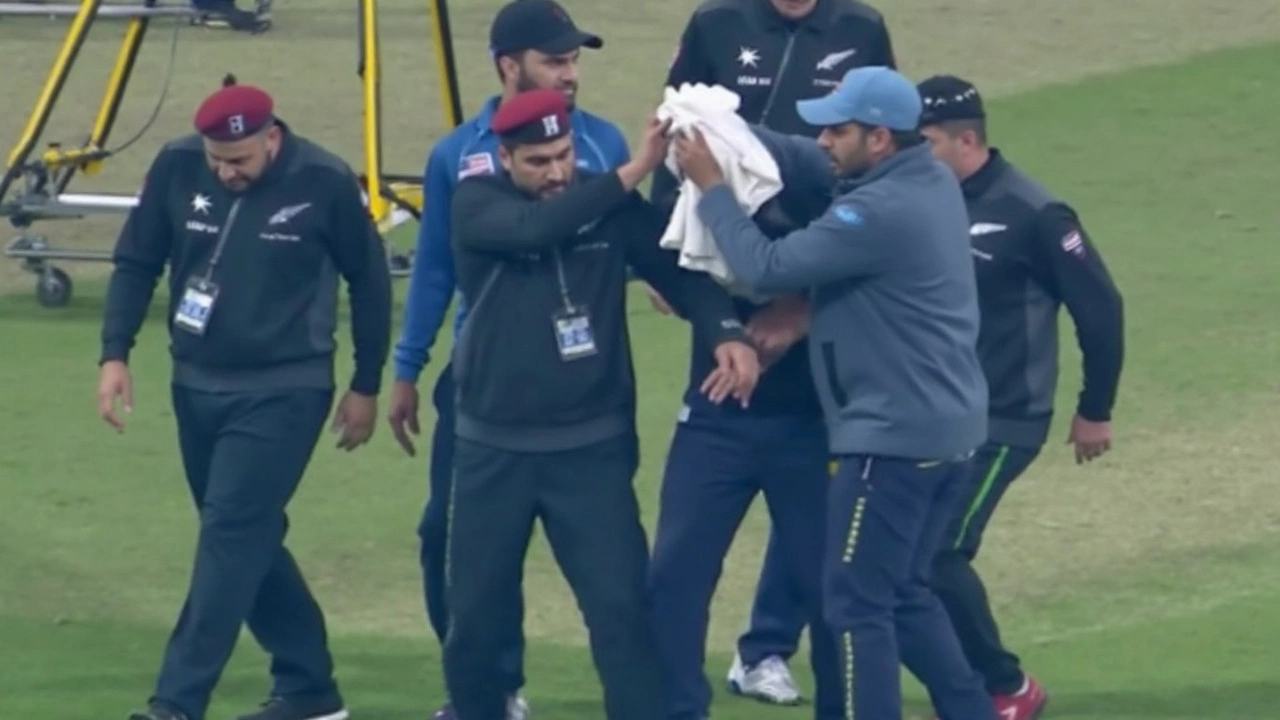
A Shocking Blow at Gaddafi Stadium
You don’t expect a routine catch to turn into a full-blown medical emergency, but that’s exactly what happened to Rachin Ravindra on February 9, 2025. During a high-pressure tri-series ODI against Pakistan at Lahore’s iconic Gaddafi Stadium, Ravindra tracked a skied ball at deep square leg—only to lose it in the blinding glare of floodlights. In the chaos, the ball crashed into his forehead, leaving him sprawled on the turf, blood streaming down his face as the stadium fell silent.
The sights and sounds were unsettling: Ravindra dazed, clutching his head, teammates frantically signaling for help. New Zealand’s medical staff rushed out, immediately tending to a nasty cut above his brow. Stitches went in, and Ravindra was sent off for a Head Injury Assessment. There was worry in the Kiwi camp—not just about the present match, but for the rest of the series and beyond. Nobody would’ve blamed him for sitting out; after all, concussion risks are no joke.
But as the crowd processed the drama, the match continued with its own tension. Glenn Phillips, meanwhile, anchored New Zealand’s innings, cracking his maiden ODI century under the very lights that betrayed Ravindra. Mitchell Santner spun the screws further, grabbing three wickets and helping sculpt a 78-run win over a Pakistan side that also suffered their own setback when Haris Rauf exited midway with a side strain.
The Comeback: A Champions Trophy Heroic
Most thought it would take weeks, maybe longer, before Ravindra was seen in competitive action again. Yet, just over two weeks later, there he was—helmet strapped on, bat in hand, walking out for his Champions Trophy debut against Bangladesh. There was still a fresh scar on his forehead, a silent reminder of Gaddafi Stadium’s scare. But Ravindra looked unfazed.
Bangladesh, hungry and aggressive, set a decent target. The stakes were high: New Zealand needed a win to stay alive for the semis. Any doubts about Ravindra’s preparedness quickly vanished as he timed his strokes with the poise of a veteran. NZ fans, glued to their screens and stadium seats, watched him build his innings from the ground up—grinding, then flourishing as the ball started to ping off his blade. Picking the gaps, running hard, and punishing loose deliveries, Ravindra reached a sublime 112—not just any hundred, but a match-winning one with 23 balls and five wickets to spare. His celebration was understated, maybe a little emotional—after all, barely two weeks earlier, he was flat on the field, stitched up and uncertain if he’d play again that season.
The New Zealand dressing room, usually calm, erupted. Coaches and physiotherapists got their share of high-fives. Behind the scenes, those same medics had monitored him around the clock—running baseline concussion checks, managing his return-to-play protocols, and keeping an eye on his fitness. The teamwork off the field mattered as much as what Ravindra did on it.
His return didn’t just secure New Zealand’s Champions Trophy semifinal slot; it pumped up the morale of a squad hit by injuries and tough fixtures. Suddenly, “resilient” wasn’t just a buzzword—it was personified by a 25-year-old who refused to let a freak injury define his tour.
Stories like Ravindra’s are why cricket is unpredictable and addictive. One moment, heartbreak. The next, a comeback that makes all the difference in the campaign. For him, that scar’s now a badge of honour—proof that hard knocks, with a bit of fighting spirit (and a great medical team), can lead to cricketing glory.